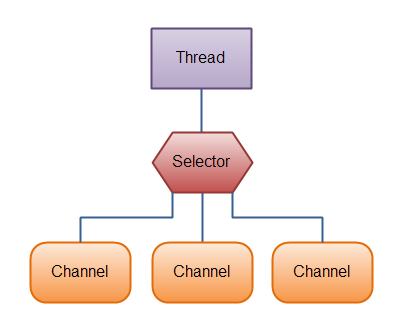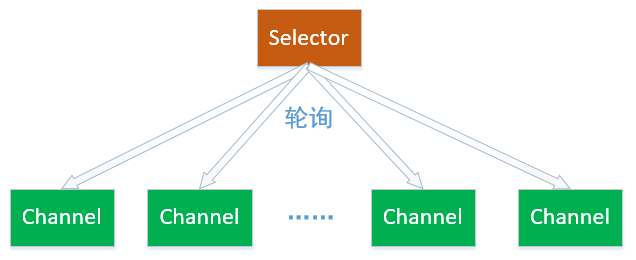Java NIO有三个核心的组件:Buffer、Channel和Selector。
在上一篇文章中,我们已经介绍了Buffer,这篇文章主要介绍剩下两个组件:Channel和Selector。

Channel
Channel翻译过来是“通道”的意思,所有的Java NIO都要经过Channel。一个Channel对象其实就对应了一个IO连接。Java NIO中主要有以下Channel实现:
- FileChannel
- DatagramChannel
- SocketChannel
- ServerSocketChannel
分别用于处理文件IO、UDP、TCP客户端、TCP服务端。
这里以ServerSocketChannel和SocketChannel为例,介绍一些常用的方法。
// server:
ServerSocketChannel serverSocketChannel = ServerSocketChannel.open();
serverSocketChannel.bind(new InetSocketAddress("127.0.0.1", 8080));
SocketChannel socketChannel = serverSocketChannel.accept();
ByteBuffer buffer = ByteBuffer.allocateDirect(1024);
int readBytes = socketChannel.read(buffer);
if (readBytes > 0) {
buffer.flip();
byte[] bytes = new byte[buffer.remaining()];
buffer.get(bytes);
String body = new String(bytes, StandardCharsets.UTF_8);
System.out.println("server 收到:" + body);
}
对于服务端来说,先用open方法创建一个对象,然后使用bind方法绑定端口。
绑定以后,使用accept方法等待新的连接进来,这个方法是阻塞的。一旦有了新的连接,才会解除阻塞。再次调用可以阻塞等待下一个连接。
与Buffer配合,使用read方法可以把数据从Channel读到Buffer里面,然后做后续处理。
// Client:
SocketChannel socketChannel = SocketChannel.open();
socketChannel.connect(new InetSocketAddress("127.0.0.1", 8080));
ByteBuffer buffer = ByteBuffer.allocateDirect(1024);
buffer.put("hi, 这是client".getBytes(StandardCharsets.UTF_8));
buffer.flip();
socketChannel.write(buffer);
对于客户端来说,有一些微小的区别。客户端不需要bind监听端口,而是直接connect去尝试连接服务端。
同样与Buffer配合,Channel使用write方法可以把数据从Buffer写到Channel里,然后后续就可以做网络传输了。
Selector
Selector翻译过来叫做“选择器”,Selector允许一个线程处理多个Channel。Selector的应用场景是:如果你的应用打开了多个连接(Channel),但每个连接的流量都很低。比如:聊天服务器或者HTTP服务器。
使用Selector很简单。使用open方法创建一个Selector对象,然后把Channel注册到Selector上。
// 创建一个Selector
Selector selector = Selector.open();
// 把一个Channel注册到Selector
socketChannel.configureBlocking(false);
socketChannel.register(selector, SelectionKey.OP_READ);
需要注意的是,一定要使用configureBlocking(false)把Channel设置成非阻塞模式,否则会抛出IllegalBlockingModeException异常。
Channel的register有两个重载方法:
SelectionKey register(Selector sel, int ops) {
return register(sel, ops, null);
}
SelectionKey register(Selector sel, int ops, Object att);
对于ops参数,即selector要关心这个Channel的事件类型,在SelectionKey类里面有这样几个常量:
- OP_READ 可以从Channel读数据
- OP_WRITE 可以写数据到Channel
- OP_CONNECT 连接上了服务器
- OP_ACCEPT 有新的连接进来了
如果你对不止一种事件感兴趣,使用或运算符即可,如下:
int interestSet = SelectionKey.OP_READ | SelectionKey.OP_WRITE;
需要注意的是,FileChannel只有阻塞模式,不支持非阻塞模式,所以它是没有register方法的!
第三个参数att是attachment的缩写,代表可以传一个“附件”进去。在返回的SelectionKey对象里面,可以获取以下对象:
- channel():获取Channel
- selector():获取Selector
- attachment():获取附件
- attach(obj):更新附件
除此之外,还有一些判断当前状态的方法:
- isReadable()
- isWritable()
- isConnectable()
- isAcceptable()
一般来说,我们很少直接使用单个的SelectionKey,而是从Selector里面轮询所有的SelectionKey,比如:

while (selector.select() > 0) {
Iterator<SelectionKey> keyIterator = selector.selectedKeys().iterator();
while(keyIterator.hasNext()) {
SelectionKey key = keyIterator.next();
if (key.isReadable()) {
SocketChannel socketChannel = (SocketChannel) key.channel();
// read
} else if(key.isAcceptable()) {
// accept
}
// 其它条件
keyIterator.remove();
}
}
Selector可以返回两种SelectionKey集合:
- keys():已注册的键的集合
- selectedKeys():已选择的键的集合
并不是所有注册过的键都仍然有效,有些可能已经被cancel()方法被调用过的键。所以一般来说,我们轮询selectedKeys()方法。
完整的示例代码
以下是一个完整的Server-Client Demo:
Server:
public class Server {
public static void main(String[] args) {
try (
ServerSocketChannel serverSocketChannel = ServerSocketChannel.open();
Selector selector = Selector.open();
) {
serverSocketChannel.bind(new InetSocketAddress("127.0.0.1", 8080));
serverSocketChannel.configureBlocking(false);
System.out.println("server 启动...");
serverSocketChannel.register(selector, SelectionKey.OP_ACCEPT);
while (selector.select() > 0) {
Iterator<SelectionKey> keyIterator = selector.selectedKeys().iterator();
while(keyIterator.hasNext()) {
SelectionKey key = keyIterator.next();
if (key.isReadable()) {
ByteBuffer buffer = ByteBuffer.allocateDirect(1024);
SocketChannel socketChannel = (SocketChannel) key.channel();
int readBytes = socketChannel.read(buffer);
if (readBytes > 0) {
buffer.flip();
byte[] bytes = new byte[buffer.remaining()];
buffer.get(bytes);
String body = new String(bytes, StandardCharsets.UTF_8);
System.out.println("server 收到:" + body);
}
} else if(key.isAcceptable()) {
SocketChannel socketChannel = serverSocketChannel.accept();
socketChannel.configureBlocking(false);
socketChannel.register(selector, SelectionKey.OP_READ);
}
keyIterator.remove();
}
}
} catch (IOException e) {
e.printStackTrace();
}
}
}
Client:
public class Client {
public static void main(String[] args) {
try (
SocketChannel socketChannel = SocketChannel.open();
) {
socketChannel.connect(new InetSocketAddress("127.0.0.1", 8080));
System.out.println("client 启动...");
ByteBuffer buffer = ByteBuffer.allocateDirect(1024);
buffer.put("hi, 这是client".getBytes(StandardCharsets.UTF_8));
buffer.flip();
socketChannel.write(buffer);
} catch (IOException e) {
e.printStackTrace();
}
}
}


 随时随地看视频
随时随地看视频




